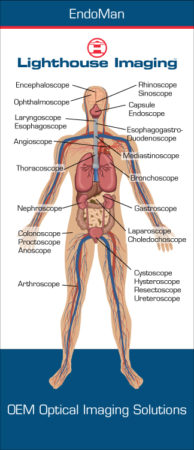LARYNGOSCOPE: The laryngoscope is used to examine the larynx, the multi-functional organ in the neck containing the vocal cords.

ENCEPHALOSCOPE: The encephaloscope is used for examining cavities in the brain.
ESOPHAGOSCOPE: The esophagoscope is used to examine the inside of the esophagus.
THORACOSCOPE: The thoracoscope is an endoscope for examining the pleural cavity through an intercostal space.
ANGIOSCOPE: The angioscope is used to observe blood vessels. It is normally a very narrow (eg 0.5mm) flexible fiber endoscope. The image transfer is usually accomplished with fused silica image conduit with outer diameter of 0.5mm or even 0.35mm. The objective lens system is by necessity of its small size a Selfoc™ lens.
NEPHROSCOPE: The nephroscope is used in the examination of the kidneys.
COLONOSCOPE: The colonoscope is used to examine the lower part of the bowel.
PROCTOSCOPE: The proctoscope is a speculum for inspecting the rectum.
ARTHROSCOPE: The arthroscope is an endoscope for examining the interior of a joint. The most common arthroscope by far has a 4mm diameter with a 30 degree direction-of-view and is used for diagnosing and treating knee problems. Arthroscopes are rigid devices made up of a stack of optical lenses. The arthroscope eyepiece is normally interfaced with a video camera.
RHINOSCOPE: The rhinoscope is a speculum used in nasal examinations.
ESOPHAGOSCOPE: The esophagoscope is used for examining the passage extending from the pharynx to the stomach.
BRONCHOSCOPE: The bronchoscope is a device for examining the interior of the bronchi.
MEDIASTINOSCOPE: The mediastinoscope is used to examine the mediastinum whcih is the mass of tissues and organs separating the two lungs. This includes the heart and its large vessels, the trachea, the esophagus, etc.
GASTROSCOPE: The gastroscope is an endoscope for inspecting the interior of the stomach.
LAPAROSCOPE: The laparoscope is used to examine the peritoneal cavity and is the most common endoscope utilized by the general surgeon. The most common laparoscope is a rigid unit 10mm in diameter with approximately 300 insertion depth.
AMNIOSCOPE: The amnioscope is used to examine the fetus through the cervical canal before the membrane is broken.
CYSTOSCOPE: The cystoscope is used for examining the urinary tract. It is similar optically to the arthroscope but has a longer insertion depth.
HYSTEROSCOPE: The hysteroscope is an endoscope used to examine the canal of the uterine cervix and the uterine cavity.
